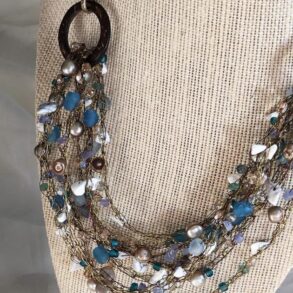Editor’s Note: This story originally appeared in On Balance, the ARTnews newsletter about the art market and beyond. Sign up here to receive it every Wednesday.
When most people talk about the art market, they talk about the pieces by Pablo Picasso, Jean-Michel Basquiat, Jeff Koons, and others that regularly sell for tens of millions of dollars. What those observers don’t talk about, most of the time, is South Asian art.
“Historically, in the larger art world, Indian art, Bangladeshi art, and Pakistani art has been severely undervalued,” art adviser and art dealer Arushi Kapoor told ARTnews. But that is starting to change as the prices for South Asian artists rise, even as talk of a market correction continues.
This past March, Sotheby’s brought in $19.8 million for its South Asian modern and contemporary art evening sale during Asia Week New York. Last year, the same sale made less than half that, just $7 million. In 2020, just before lockdown set in, Sotheby’s brought in $4.8 million at its South Asian modern and contemporary art evening sale during Asia Week.
“This market has come a long way, even in the last four or five years,” Manjari Sihare-Sutin, vice president and worldwide co-head Sotheby’s modern and contemporary South Asian art department, told ARTnews.
Experts said there were several factors behind this rise in activity: more high-quality lots coming to auction, a growing collector base, and the shrinking availability of work by the Progressive Artists Group, a network of modernists that was active in post-Partition India.
Nishad Avari, the New York–based head of Christie’s South Asian modern and contemporary art department, which also brought in nearly $20 million for its Asia Week sale in March, described a sense of competition among collectors for works such as those. “They realized that if there are museums participating in the acquisition process, those works are never going to come back to market,” he explained. “So, they have to step up the level at which they compete.”
“There’s real demand from Indian citizens that don’t want to send the best works abroad,” Kapoor said. “They want to keep the best works in their house.”
And while the category has grown to include artists such as Nasreen Mohamedi, Nilima Sheikh, Zubeida Agha, and Zainul Abedin, the biggest sales have been and continue to be for works by male Indian artists.
These include new auction records for Indian modernists like S.H. Raza and F.N. Souza. At Sotheby’s, Raza’s painting Kallisté (1959) sold for $5.6 million on an estimate of $2 million to $3 million, smashing the artist’s previous record of $1.33 million set last March. At Christie’s, Souza’s The Lovers sold for nearly $4.9 million on an estimate of $700,000 to $1 million. The artist’s previous record of just over $4 million was for the 8-foot-wide painting Birth (1955), which also sold at Christie’s in September 2015.
Compared with the amounts typically seen in the Indian art market, “these are not small prices,” Sihare-Sutin said.
Other results were similarly high. At Christie’s, Gulammohammed Shiekh’s Portrait of a Tree (1975) sold for $1.38 million, more than $1 million above its high estimate. Meanwhile, at Sotheby’s, the late Bhupen Khakhar, a participant in the current Venice Biennale, was represented by the painting Hatha Yogi (1978), which sold for $1.8 million, more than double its high estimate. Neither work set a record, but these prices suggest that there is a good amount energy fueling the market for Indian art right now.
That energy is partially the result of efforts to study and acquire South Asian art at institutions such as the Guggenheim Museum, Tate, and the Museum of Modern Art, themselves part of a larger attempt to expand the history of modernism. That’s evident right now in MoMA’s permanent collection galleries, where a work by Indian painter Mohan B. Samant hangs not far from a suite of paintings by Mark Rothko. MoMA acquired the Samant painting in 1963, but prior to the museum’s recent rehang, the piece hadn’t been seen in the permanent galleries since the year after the institution obtained it.
Sotheby’s is among the auction houses seeking to bounce off this institutional momentum. The house’s educational outreach efforts for its clients have included invitation-only guided tours of exhibitions of South Asian artists, like Shahzia Sikander’s show at New York’s Morgan Library in 2021. And in 2023, the year that Paris’s Centre Pompidou mounted a Raza retrospective, Sotheby’s staged a non-selling exhibition focused on the artist at its offices in London.
“No matter where someone entered the building, they could not miss the Raza exhibition,” Sihare-Sutin said. “We had contemporary clients come and look.”
The pieces coming up for sale tend not to be the product of flipping. “It’s 90 to 95 percent privately sourced, fresh-to-market property,” Sihare-Sutin said. “We have to be careful and cognizant of the ecosystem. The galleries are doing great work. We have to be responsible and think about who we want to sell it to.”
Avari echoed this, saying his clientele is mainly long-term collectors. Like Sihare-Sutin, he said his focus was generally modern art over contemporary art. “We’re still establishing ourselves in the primary market,” he explained. “Unlike other categories, we don’t have that phenomenon of studio to auction block necessarily. These are all works that have been in established collections and traded hands a couple of times.”
(That hasn’t stopped advisers like Kapoor getting more inquiries from non-Indian international collectors about acquiring South Asian works as alternative investment assets. “There’s an opportunity currently to spend a certain amount of money to get a really good art piece, which also has significant upside,” she said.)
According to Sihare-Sutin, there’s a misconception that the market for South Asian modern and contemporary is a regional one. If you follow that logic, much of the interest in South Asian art should come from within South Asia itself. But, she said, this all fails to consider how large and successful the diaspora is in the United States.
“The CEO of every top company is Indian,” she pointed out.








